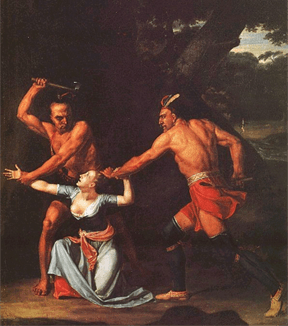The Savage Indian

The Native Americans are frequently portrayed in modern fiction as a tragic group of people subject to prejudice of the White Man and now are suffering in an age of darkness. Seems like it is standard fare for Native Americans to be like that?
Not quite.
Though not common today, in older works the default was the Savage Indian, a native of their land who is a bloodthirsty man or woman who only wishes to kill and hunt trophies for the sake of satiating their unquenchable thirst or desire for heads. They are brutal, uncompromising and are all too willing to let allies take the fall. They are most of the time exiled by their tribes for being too violent, but if a foreigner comes in, expect the Savage Indian to reject the outsider first with a weapon up their vital organs. Sometimes they will be the rival tribe/griyo that the Noble Indians want to see defeated or at least no longer hurting them and the people they are making peace with but couldn't due to unfortunate damage done by them.
This trope has ancient forerunners as practically every culture has identified a more primitive neighbor as "savages", particularly when there existed a conflict of interests. It became especially common in the age of imperialism during which blatantly racist ideas were used to advance a policy of European nations "civilizing" the rest of the world. In the United States, expanding settlers repeatedly came into conflict with the native tribes. Infrequent abhorrent acts of violence perpetrated by the natives against the intruders led to the perception that all natives were brutal savages, especially considering that the settlers were all saints. Battles against savage Indians were commonplace in Western fiction up until the modern era, putting this on the edge of becoming a Dead Horse Trope. In the era of the "Revisionist Western," (the era in which we find ourselves) fiction often attempts to provide a more diverse and historically accurate view of violence by and against Native Americans.
Compare and Contrast Magical Native American and Noble Savage.
Anime and Manga
- In Shaman King, Hao's life 500 years ago is essentially that of a Complete Monster, going so far as to destroy entire cultures because they don't want to join him in his quest to rid the world of Muggles. One of the last survivors of that thinks that Silva and the rest are just like Hao. Which is...really weird in The Nineties.
Film
- The Apaches in Stagecoach (1939).
- Ford somewhat made amends for that portrayal, by depicting the Apaches rather more favorably in Fort Apache (1948), in which only the arrogant Thursday views the Apaches as "breech-clouted savages."
- In Calamity Jane (1953), Jane fights this kind, and brags of the number she has killed.
- In Damn Yankees (1958), the Devil recalls "Indians draggin' an empty covered wagon when scalping the settlers was the latest craze."
- Averted in Der Kaiser von Kalifornien (1936), meaning that American media were worse than the Nazis.
Literature
- Magua from The Last of the Mohicans.
- Injun Joe, the Ax Crazy villain of The Adventures of Tom Sawyer.
- Tall Tale America has these turn up whenever guys like Mike Fink or Davy Crockett get tired of shooting animals.
Professional Wrestling
- Apache Bull Ramos, the bookers wanted him to be a Face because he could wrestle well but had very little charisma. He refused though and became one of the greatest heels ever, when it came to drawing crowd heat. He mainly suffered the Worf Effect to establish the new champion's credibility.
Religion and Mythology
- The Book of Mormon portrays the Lamanites this way.
Real Life
- The Aztecs are almost always portrayed as bloodthirsty and war-loving, even in modern works. Of course, there are reasons for this bad reputation.
- In North America, the Pawnee are the only ones who practiced Human Sacrifice, of virgins from neighboring groups, but since they were allies of the U.S., they were typically portrayed more sympathetically. They underwent a meta-Face Heel Turn in the movies around the time the Sioux underwent a meta-Heel Face Turn.
- This used to be a major draw at Disneyland, back when Westerns were popular. Aside from the Indian Village, Tom Sawyer's Island included an eternally burning shack with arrows in the side of it. As attitudes changed, it was given several different backstories before it became just a shack.
- The anthropologist, Napoleon Chagnon, who ventured into the Venezuelan jungle in the 1960s to study the Yąnomamö tribe, released accounts of a perpetually violent society beset by wars and constant strife. Chagnon believed he found a society in which homicide and warfare were common and most violent men wound up with the most wives and children. Whether or not his views were really founded on actual fact or visualizing the Yąnomamö through his rough childhood, this created a lot of controversy in the anthropological world, as it was taken to justify Christian missionaries' subversion of the native culture and escalated clashes between them and nearby miners.
- As late as February 2011 Bryan Fischer, Director of Issues Analysis for the American Family Association, argued that Indians were "morally disqualified from sovereign control of American soil" by their "superstition, savagery and sexual immorality". How wrong is this statement? Let us count the ways:
- He also stated that "the Europeans proved superior in battle, taking possession of contested lands through right of conquest. So in all respects, Europeans gained rightful and legal sovereign control of American soil." So might clearly equals legal right in his worldview.
- The Europeans didn't always prove superior in battle, and that the United States acquired much of its land not by force, but by making treaties and business deals whose terms the US never intended to keep. Several Indian tribes had their lands taken over despite never being officially beaten on the battlefield.